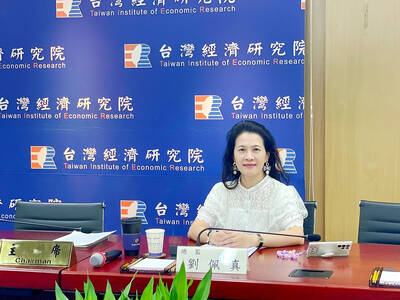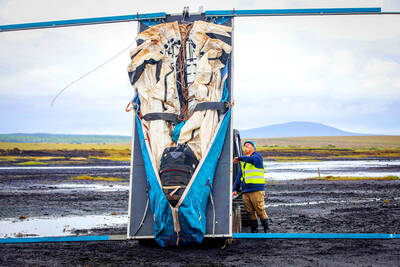Nissan’s Teana sedan has a full-size back seat, conservative looks and a reasonable price — just the thing for a Chinese entrepreneur with a family.
That Chinese buyer is why the car exists. Nissan says the Teana, though also sold in Japan and other countries, was created with China in mind — one of a growing number of models designed by global automakers for the world’s biggest car market.
“The Teana is a Chinese product,” Nissan Motor Co CEO Carlos Ghosn said at this week’s Beijing auto show. “Without any doubt, the Chinese consumer now is becoming a big target for a lot of products that we are developing.”
China’s car buyers have become an important force in the design decisions of automakers from Nissan to General Motors Co (GM) to Volkswagen AG. Their influence is starting to be seen in vehicles sold worldwide.
The reason is obvious: China’s auto market surged past the US last year to become No. 1 at a time when sales elsewhere are so weak that major brands make most of their global profit in China.
“From volume cars to luxury cars, we can see that all carmakers are trying to design cars to fit Chinese tastes,” said John Zeng (曾志凌), an analyst for IHS Global Insight.
Automakers are modifying luxury cars to suit China’s new rich and creating scaled-down sedans and minivans for the populous but lower-income family market.
China’s growing influence echoes defining periods of expansion in the industry’s history — from Europe to Detroit a century ago and the rise of Japan since the 1970s.
GM was a pioneer in designing for the Chinese market. Its Cadillac unit created its 2008 CTS for China, giving it a bigger back seat for Chinese buyers who sit in the back and have drivers. That model was sold worldwide, so Cadillac customers everywhere got the added legroom.
Other producers are following. Daimler AG’s Mercedes-Benz debuted an extended E-class sedan for China at the Beijing auto show. Ford Motor Co’s Volvo Cars and Volkswagen AG’s Audi have created Chinese models with bigger back seats.
Luxury makers are giving cars a longer wheelbase and stronger suspension for a smooth ride on China’s rougher city streets.
China had almost no private cars 15 years ago, but sales have grown so fast since then that the country already is the biggest market for VW, Europe’s biggest automaker. It could replace the US as GM’s top market by vehicles sold as early as this year. GM sold 2.1 million cars and trucks in the US last year and says total China sales of all its brands, including those with local partners, should pass 2 million this year.
“The lines are going to cross. It’s only a matter of when,” said Tim Lee, GM’s president for international operations outside North America and Europe.
Automakers and industry analysts say Chinese car ownership levels are still so low that sales, from luxury to economy brands, should grow strongly in coming years as millions of families buy their first car.
In the mass market, China-inspired cars mix smaller size and lower price with bigger vehicles’ more sober styling and focus on interior room. That is aimed at first-time buyers who might be middle-aged with children or a business and care about practical transportation, not sporty looks.
Nissan’s Teana is priced at 177,000 to 366,000 yuan (US$25,900 to US$53,600) — several times China’s average annual income of about US$3,000 per person but much less than a similar-size car costs abroad. Nissan sold 35,400 Teanas in China from January to last month, up 88 percent from the same time last year, according to J.D. Power.
GM’s compact Sail, designed for China and made with a local partner, Shanghai Automotive Industry Corp (SAIC, 上海汽車工業總公司), is priced at 57,000 yuan to 69,000 yuan. GM’s compact Wuling Zhiguang minivan also made with SAIC, costs 37,000 yuan to 46,000 yuan.
Chrysler LLC linked up with a Chinese partner, Chery Automobile Co (奇瑞汽車), to turn one of its low-priced models into a compact for the US market but the alliance was called off after the global crisis hit.
China’s influence extends to products marketed by global automakers in other developing markets.
GM and SAIC announced in December last year they will expand their partnership to India to make and sell Wuling minivans and flatbed trucks. Last year, Wuling became the first brand in China to top 1 million units in annual sales.
“We are currently exporting Wuling products to a number of markets in Africa and in South America very successfully,” Lee said. “We know we will be successful in India as well.”
Ford is following a different strategy, using Chinese market research to help design global vehicle platforms rather than creating a China model, said Joe Hindrichs, Ford’s president for Asia-Pacific and Africa.
“What’s most important to us is that we have Chinese input from consumer research and Chinese employees into the design process of our products so we get Chinese desires and perspectives,” Hindrichs said. “We are doing that on all our global products because we know how important the Chinese market is.”
At the Beijing auto show, Ford displayed a micro-compact concept car, the Start, with a three-cylinder engine. Its chief designer, J Mays, said Ford had crowded Chinese cities in mind when it created the car.
Automakers also are turning to China for design talent.
Nissan plans to open a Beijing design center next year. It would be the first in China for a Japanese automaker and add to Nissan studios in Japan, Britain and the US.
“We are going to hire a lot of Chinese designers,” Ghosn said.

A proposed 100 percent tariff on chip imports announced by US President Donald Trump could shift more of Taiwan’s semiconductor production overseas, a Taiwan Institute of Economic Research (TIER) researcher said yesterday. Trump’s tariff policy will accelerate the global semiconductor industry’s pace to establish roots in the US, leading to higher supply chain costs and ultimately raising prices of consumer electronics and creating uncertainty for future market demand, Arisa Liu (劉佩真) at the institute’s Taiwan Industry Economics Database said in a telephone interview. Trump’s move signals his intention to "restore the glory of the US semiconductor industry," Liu noted, saying that

On Ireland’s blustery western seaboard, researchers are gleefully flying giant kites — not for fun, but in the hope of generating renewable electricity and sparking a “revolution” in wind energy. “We use a kite to capture the wind and a generator at the bottom of it that captures the power,” said Padraic Doherty of Kitepower, the Dutch firm behind the venture. At its test site in operation since September 2023 near the small town of Bangor Erris, the team transports the vast 60-square-meter kite from a hangar across the lunar-like bogland to a generator. The kite is then attached by a

Foxconn Technology Co (鴻準精密), a metal casing supplier owned by Hon Hai Precision Industry Co (鴻海精密), yesterday announced plans to invest US$1 billion in the US over the next decade as part of its business transformation strategy. The Apple Inc supplier said in a statement that its board approved the investment on Thursday, as part of a transformation strategy focused on precision mold development, smart manufacturing, robotics and advanced automation. The strategy would have a strong emphasis on artificial intelligence (AI), the company added. The company said it aims to build a flexible, intelligent production ecosystem to boost competitiveness and sustainability. Foxconn

STILL UNCLEAR: Several aspects of the policy still need to be clarified, such as whether the exemptions would expand to related products, PwC Taiwan warned The TAIEX surged yesterday, led by gains in Taiwan Semiconductor Manufacturing Co (TSMC, 台積電), after US President Donald Trump announced a sweeping 100 percent tariff on imported semiconductors — while exempting companies operating or building plants in the US, which includes TSMC. The benchmark index jumped 556.41 points, or 2.37 percent, to close at 24,003.77, breaching the 24,000-point level and hitting its highest close this year, Taiwan Stock Exchange (TWSE) data showed. TSMC rose NT$55, or 4.89 percent, to close at a record NT$1,180, as the company is already investing heavily in a multibillion-dollar plant in Arizona that led investors to assume